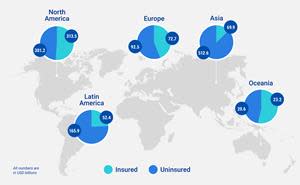Insurance Industry Faces Average Annual Natural Catastrophe Losses of $133B, A New High According to Verisk Report


Exposure growth and inflation continue to drive increasing losses
2023 Global Protection Gap Map


BOSTON, Sept. 08, 2023 (GLOBE NEWSWIRE) -- The global modeled insured average annual loss from natural catastrophes is $133 billion, a new high captured in the latest analysis using Verisk’s extreme event solutions models. Not only should the insurance industry be prepared to experience total insured losses from natural catastrophes well in excess of $100 billion every year, but annual losses greater than $200 billion are also plausible. These values are up significantly over the decade, according to the 2023 Global Modeled Catastrophe Losses Report published by Verisk (Nasdaq: VRSK).
“The growth in exposure values, driven primarily by continued construction in high-hazard areas, and rising replacement costs - largely due to inflation - are the most significant factors responsible for increasing catastrophe losses,” said Bill Churney, president of Verisk extreme event solutions. “The other significant factor is the impact of climate change, which is often cited as the primary reason for the increase in losses. But, while this plays a role, year-over-year growth of exposure and rising replacement values have a far greater short-term impact.”
No longer just hurricanes and earthquakes, thunderstorms responsible for 70 percent of insured losses
Losses from the hazards beyond the traditional peak perils of hurricanes and earthquakes, including flood, severe thunderstorm, and wildfire, now account for a much larger proportion of the overall annual losses, due to the combination of more frequent events and more valuable properties at risk.
Severe thunderstorms have been responsible for a growing proportion of the losses over the last five years and can no longer be considered a “secondary peril”. So far in 2023, severe thunderstorms have accounted for more than 70 percent of insured losses with eight multi-billion-dollar events and according to this year’s report, the contribution to the Global Average Annual Loss (AAL) insured from severe thunderstorms globally is nearly 40 percent. U.S. severe thunderstorms are the majority of these losses, and alone make up 21 percent of the total global AAL.
Economic losses could exceed $400 billion, highlighting a global protection gap
Verisk has determined that the global insured losses only make up approximately a third of global economic losses. The company estimates that annual economic losses could exceed $400 billion, a staggering figure that highlights the insurance protection gap that exists around the world.
The sizable difference between insured and economic losses—the protection gap—represents the cost of catastrophes to society. On a regional basis, the percentage of economic loss from natural disasters that is insured varies considerably. In North America, for example, about 51 percent of the economic loss from natural disasters is insured, while in Asia, insured losses account for only about 12 percent of economic losses, respectively, reflecting the very low insurance penetration in these regions.
The Verisk AAL is generally the sum of losses that can be expected, on average, every year. The global exceedance probability curve generated by Verisk’s suite of models provides probabilities on many different levels of loss, with significantly higher losses expected to occur with relatively high frequencies. According to the year’s report, Verisk estimates the global insured 1 percent, or 100-year loss is $370B. With this information, companies can prepare for large loss years and truly own their risk with confidence so that they can help weather these challenging years without risking their solvency.
Churney continued, “Probabilistic catastrophe modeling remains the best approach for understanding risk and (re)insurers can use these models, with current exposure information, to put recent losses in perspective, while accounting for the impacts of continued exposure growth, climate change, and the increased role of perils beyond tropical cyclones and earthquakes.”
Download the 2023 Global Modeled Catastrophe Losses report here.
###
About Verisk
Verisk (Nasdaq: VRSK) is a leading strategic data analytics and technology partner to the global insurance industry. It empowers clients to strengthen operating efficiency, improve underwriting and claims outcomes, combat fraud and make informed decisions about global risks, including climate change, extreme events, ESG and political issues. Through advanced data analytics, software, scientific research and deep industry knowledge, Verisk helps build global resilience for individuals, communities and businesses. With teams across more than 20 countries, Verisk consistently earns certification by Great Place to Work and fosters an inclusive culture where all team members feel they belong. For more, visit Verisk.com and the Verisk Newsroom.
Attachment
CONTACT: Media Contact: Mary Keller 617-954-1754 Mary.keller@verisk.com

